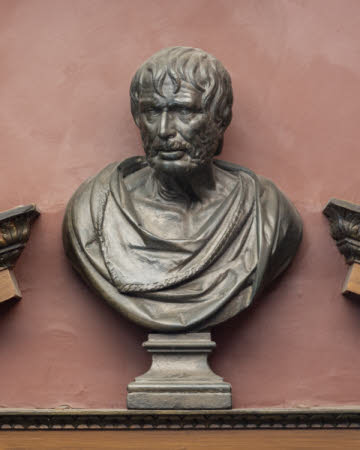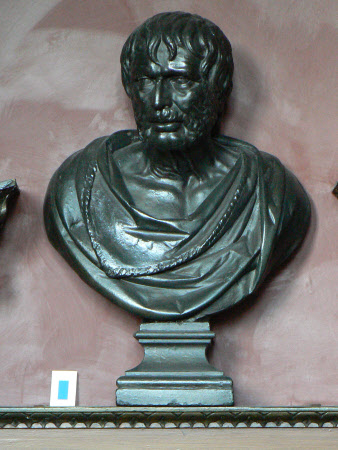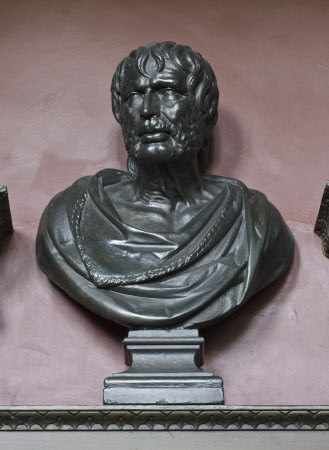Bust of Lucius Annaeus Seneca (c. 4 BC - 65 AD)
workshop of Peter Besnier (fl.1643, d.1687-93)
Category
Art / Sculpture
Date
c. 1600 - 1672
Materials
Plaster, Paint
Place of origin
London
Order this imageCollection
Ham House, Surrey
NT 1139679
Summary
Plaster, painted; portrait bust of the Roman philosopher Lucius Annaeus Seneca (c. 4 B.C. – A.D. 65); workshop of Peter Besnier (died 1687/88); 1637-39 or c. 1671-72. Wearing a loose furred cloak. On a rectangular moulded socle. The plaster is painted black to simulate bronze. One of a group of plaster busts installed on the Great Staircase of Ham House in 1671/72.
Full description
A plaster portrait bust of the Roman philosopher Lucius Annaeus Seneca (c. 4 B.C. – 65 A.D.). Seneca is depicted as a gaunt and anguished figure, with longish hair and a scraggy moustache and beard. On an integral rectangular moulded and indented socle. The plaster is now painted black to simulate bronze. Lucius Annaeus Seneca was the son of the rhetorician Marcus Annaeus Seneca and became one of the most celebrated of Roman philosophers. After having been banished from Rome by the emperor Caligula, Seneca was recalled to Rome by Agrippina, the mother of Domitius, who would subsequently become the emperor Nero. Seneca became tutor to the young man and his adviser when he became emperor, attempting to reign in Nero’s more vicious tendencies, although at the same time he amassed great wealth for himself. Seneca also sided with Nero in his increasingly bitter dispute with his mother Agrippina, which led in A.D. 60 to the death of Agrippina, allegedly at the hands of her son. Nero gradually became jealous of Seneca’s wealth and resented his influence and in 65, after the failure of a conspiracy in which the philosopher had probably played no part, Nero nevertheless ordered Seneca to kill himself. Seneca died with dignity, famously cutting his veins and then immersing himself in a warm bath in order to dull the pain and hasten his demise. Assuming the busts are in their original positions, the juxtaposition on the Great Staircase of Seneca with his former pupil and eventual nemesis Nero makes a powerful statement. Four plaster busts were installed on the Great Staircase of Ham House in 1671/72, and recorded in the 1677 Ham House inventory as ‘4 heades of plaster’ (Charles Avery, Seventeenth-Century Sculpture at Ham House’ in Christopher Rowell, ed., Ham House. 400 Years of Collecting and Patronage, New Haven/London 2013, pp. 158-77, p. 169). These correspond to the four busts in the broken pedimented overdoors leading off various points of the Great Staircase (NT 1139665; 1139678-80), three of which have identical stepped socles to the three other busts on the Staircase today, where they are set on wooden console brackets made in 1673. The similar socles would suggest that the three busts were made at the same time and presumably as part of the same order as the four recorded in 1677, although Charles Avery suggested that the four busts above the overdoors were likely to have been made earlier. c. 1637-39. Virtually all the sculpture at Ham House, including the busts on the staircase and those in lead set along the garden walls and on the façade of the house, seems to have been made in the workshops of the Besnier family. French in origin, members of the family were appointed as ‘Sculptor in Ordinary’ to, successively, Kings Charles I and II, beginning with Isaac Besnier, who was employed to look after the ‘Moulds, Statues and Modells’ in the royal collections. Isaac probably arrived in London around 1625, perhaps in the retinue of Charles I’s bride Henrietta Maria, and may have left by 1643, when his responsibilities for the sculptures in the royal collections were transferred to his younger brother Peter Besnier (fl. 1643, died 1687/88), to whom is attributed the magnificent bronze bust of Catherine Bruce at Ham House (NT 1139887) as well as the plaster figures of Mars and Minerva in the Great Hall (NT 1139652.1 & 2). After the Restoration Peter Besnier petitioned the new king for restoration of his post and continued to work as a sculptor. His son Thomas (c. 1663-1693) was much praised by George Vertue, whilst another family member, John Besnier, was recorded in 1681 making lead statues for the Duke of Ormonde. Given the close relations between successive monarchs and the owners of Ham, the hypothesis that the Besnier, in the service of the Crown, might have made much of the sculpture at Ham House, is quite plausible. As keepers of the royal sculpture collections, Isaac and Peter Besnier would have enjoyed privileged access to these collections. The busts on the Great Staircase were originally painted white to resemble statuary marble but were repainted dark in the nineteenth century, to give them the appearance of bronze. Jeremy Warren January 2022
Provenance
Elizabeth Murray and John Maitland, 1st Duke and Duchess of Lauderdale, c. 1661-72; thence by descent, until acquired in 1948 by HM Government when Sir Lyonel, 4th Bt (1854 – 1952) and Sir Cecil Tollemache, 5th Bt (1886 – 1969) presented Ham House to the National Trust. Entrusted to the care of the Victoria & Albert Museum until 1990, when returned to the care of the National Trust, to which ownership was transferred in 2002.
Makers and roles
workshop of Peter Besnier (fl.1643, d.1687-93), sculptor
References
Avery 2013: Charles Avery, ‘Seventeenth-century Sculpture at Ham House’ in Christopher Rowell, ed., Ham House. 400 Years of History, New Haven/London 2013, pp. 158-77., pp. 169-70.


